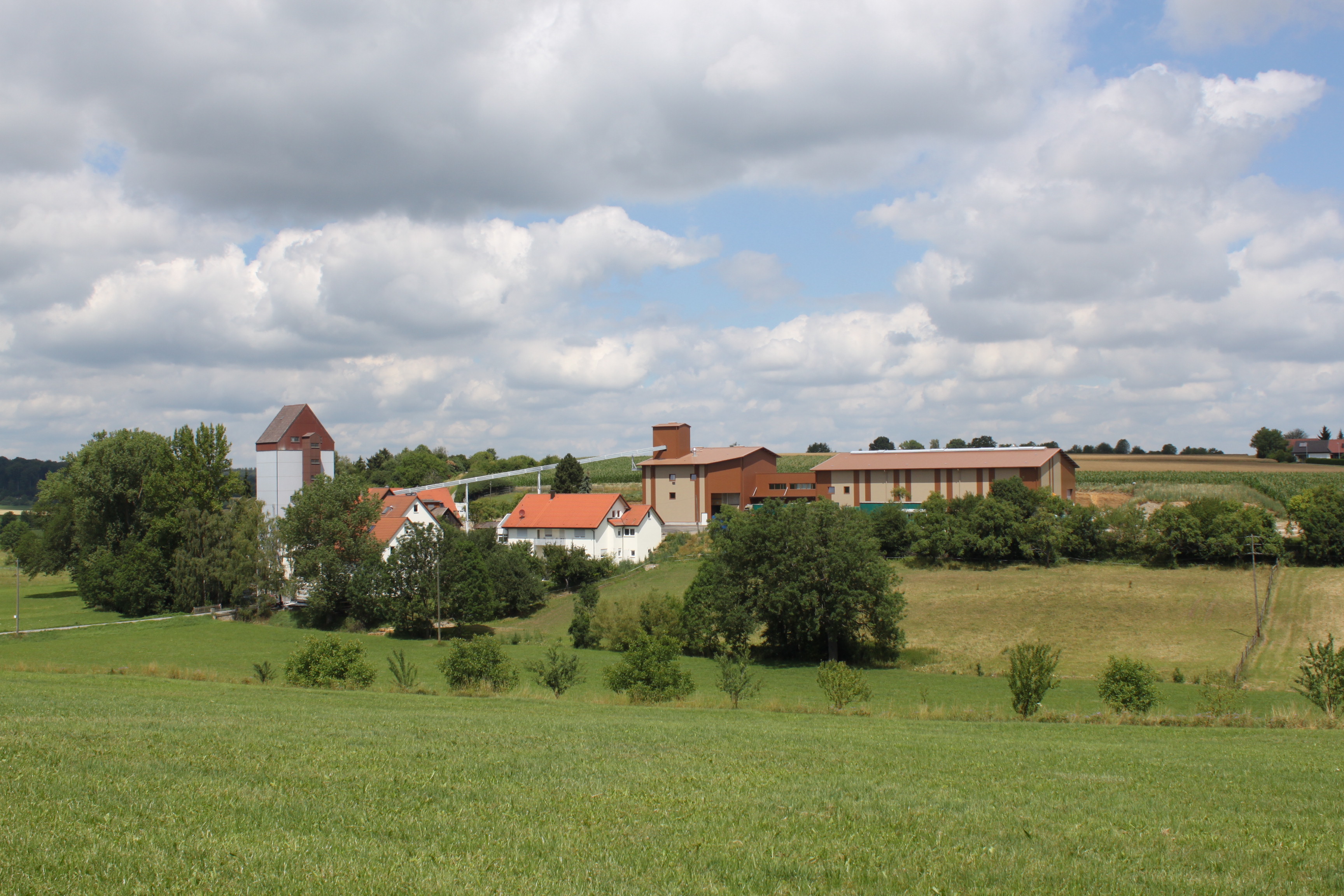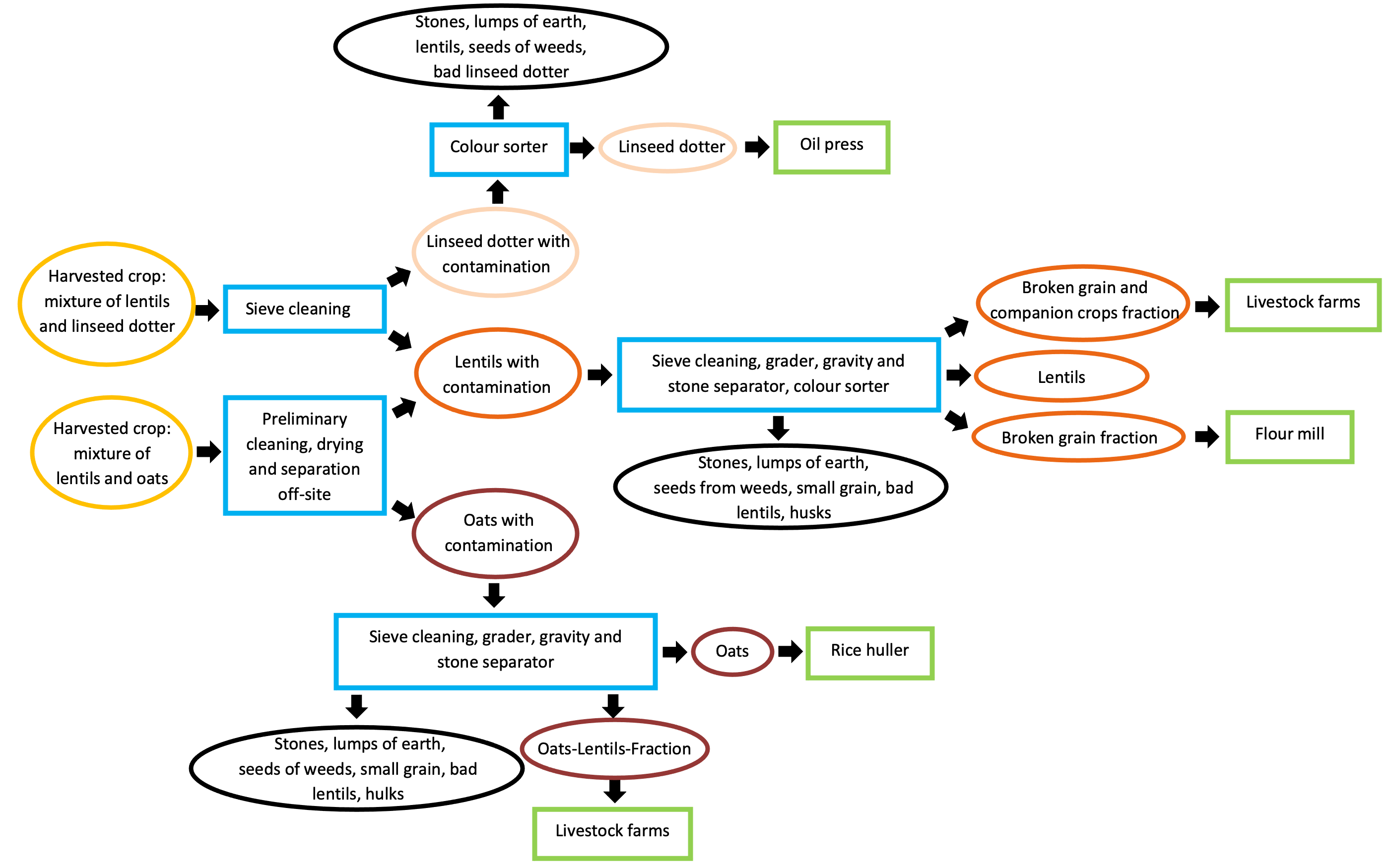Main navigation
Lentil cleaning in the Altdorf mill
The Altdorf mill, just under 7 km south of the city of Böblingen, has operated lentil cleaning facilities since 2019, the year that the Sessler mill in Renningen, 20 km further north, ceased all operations including lentil cleaning. After receiving a number of enquiries from farmers and local mills, brothers Karl and Jörg Ruthardt took a chance and launched a lentil cleaning operation in addition to their mill and farm shop business.

Lentils are herbaceous plants that can grow up to 50 cm high, depending on the variety. When grown on their own, lentil plants have difficulty remaining upright, and tend to bend over, especially in heavy rain. This makes harvesting difficult and increases the risk of fungal diseases. Therefore, lentils are usually grown alongside so-called companion crops to support them. Complex cleaning measures are nevertheless required to remove the companion crops from the lentils after harvesting.
Regional farmers mainly grow Le Puy-style green lentils. The lentil plants are supported by oats or linseed dodder. The farmers bring their harvest to BayWa Agrar Heimerdingen, 30 km north of Böblingen, where the lentils are weighed and dried, coarsely cleaned using sieves and temporarily stored. "We don’t have enough space to do all this at our mill," says Karl Ruthardt. The sieves are used to remove straw, sand and soil residues. The lentils are then brought to the University of Hohenheim’s Ihinger Hof experimental station in Renningen to roughly separate the oats from the lentils. All further cleaning steps take place in Altdorf, where lentils are also separated from the linseed dodder using sieves.
Lentils go through several cleaning steps
The lentils are then cleaned in a screening machine to remove coarse impurities such as stones. The lentils are subsequently fed into a grader, which separates the round particles from the elongated ones. The grader consists of a sheet metal drum with depressions inside into which the round lentil grains fit perfectly, while elongated weed seeds or companion crop grains such as oats do not fully fit due to their shape. When the drum rotates, the different types of grains remain in the depressions for different lengths of time before falling out and being collected in different places.
Once this is done, a weight and stone separator separates heavy from light. The separator consists of an inclined deck through which low-pressure air is blown upward. Lentils and impurities float in the air flow and settle according to weight: heavy particles sink to the bottom, lighter particles rise to the top. Since the deck is simultaneously vibrating, the heavy particles float up the incline and the light particles travel downwards on top of the heavy ones. The vibrating plate has various discharge spouts and separates lentils, small and broken grains, weed seeds, stones, lumps of earth and husks.
Colour sorter blows out unwanted grains
In the final cleaning step, the lentils are put through a colour sorter. A computer is used to set the colour of the unwanted grains to be rejected. The lentils and anything else that comes with the harvest are separated on a slide. As the lentils and unwanted grains fall off the end of the slide, they are analysed by cameras, and unwanted grains are blown out at lightning speed. In this way, bad lentils, stones, lumps of earth, weed seeds, and small and broken grains can be rejected.
How often individual cleaning steps have to be repeated depends on the quality of the harvest. "Cleaning is not easy," Ruthardt admits, "we learn something new every year." He continues: "We already had the machines as they are also used for grain cleaning. We just had to invest in other sieves and grader cylinders."
The lentils are packed directly after cleaning. Twenty tonnes of lentils were packed in 2020. Some farmers then sell the lentils themselves, others do not. The farmers let the mill know in advance how many lentils they will take back. Defective lentils are ground into flour. However, Ruthardt is still looking for buyers for the flour. He comments: "It is not easy to sell the flour because of its green colour." The ‘defective lentils with the residual oats’ fraction is ground into pig feed. The best fraction of cleaned oats is processed into oat flakes, the fraction with residual lentils is also used as animal feed. The seeds are pressed to linseed dodder oil in the oil mill. "If we were able to sell more oil, we could grow more lentils with linseed dodder as a companion plant, which is much easier to separate from lentils than oats," Ruthardt explains. Linseed dodder oil has a high proportion of unsaturated fatty acids and is used as a cooking oil, in skin care, and also in technical applications.
12th generation miller

The Altdorf mill was first mentioned in documents dating back to 1487. The maternal grandfather of the current managing directors, Jörg and Karl Ruthardt, acquired the mill in 1935. The mill is a traditional flour mill. "My brother and I are the 12th generation of millers," Ruthardt says proudly. "We grind cereals into flour that comes from a 25 km radius around Altdorf. Rye is only grown in negligible amounts in Baden-Württemberg," he says. "So we buy rye from eastern Germany, Poland and the Czech Republic."
In addition to lentils and flour, the Altdorf mill also sells other products. The full product range features over 400 items, mainly from the natural foods sector. These include nuts, oat flakes, muesli, dried fruit, buckwheat and ancient grains such as emmer, einkorn and forest rye. The mill also sells individual packets of bread and cake mix. Wherever possible, the Altdorf mill relies on regional suppliers; ‘exotic’ products such as raisins and sesame seeds are imported. The products are sold through the mill’s own store, regional supermarkets and wholesalers.
With the aim of increasing lentil cultivation, some of the farmers who have their lentils cleaned at the Altdorf mill have also participated in field trials as part of the ‘Rhizo-Linse’ project. The goal of the project is to improve the nitrogen supply of lentil plants in a natural way and to identify the bioeconomic potential of lentil cultivation. Ruthardt is positive about the future of lentils. "Consumption has increased," he said. "Lentils will still always be a niche product, but it’s a niche that’s interesting."
The project will run from March 2019 to early 2022 under the European Agricultural Productivity and Sustainability Innovation Partnership (EIP-AGRI). It will be given a total of €655,500 from the European Agricultural Fund for Rural Development (EAFRD) and the Baden-Württemberg Ministry of Rural Affairs, Food and Consumer Protection.
